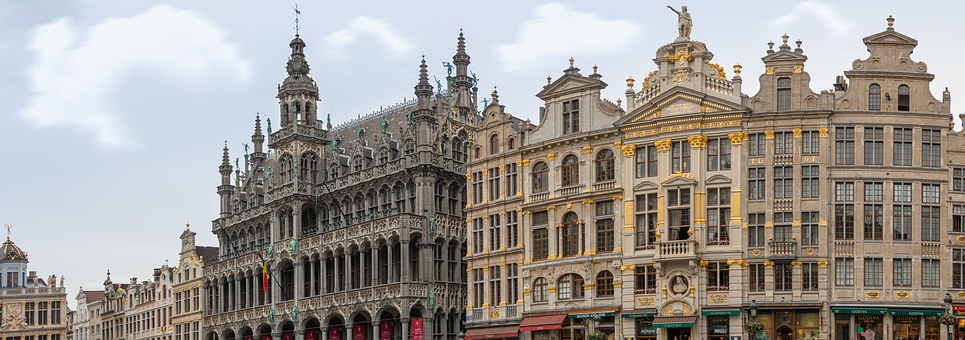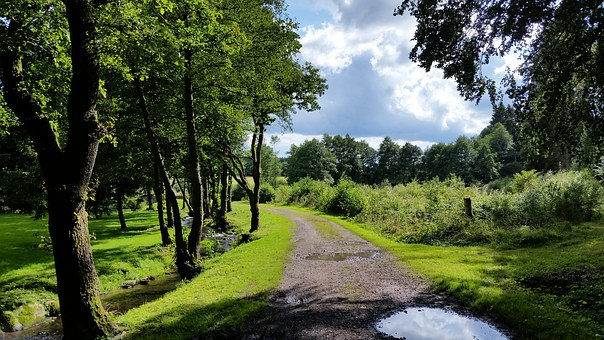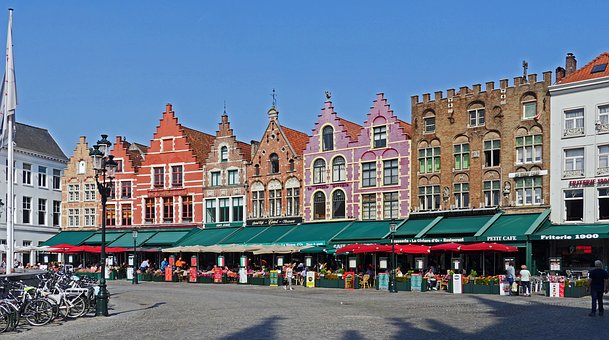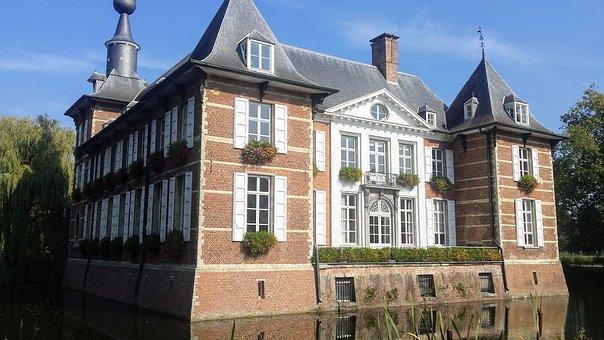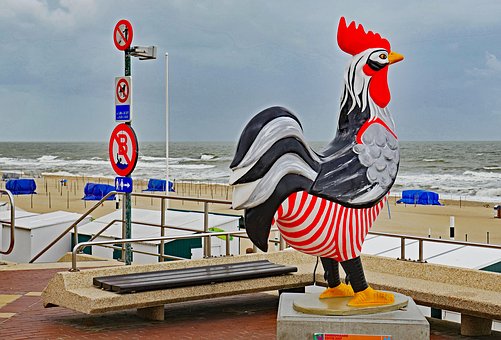Backpacking in Belgium
Belgium, a kingdom which belongs to the Benelux countries, is situated on the North Sea and borders the Netherlands, Germany, Luxembourg and France. On your backpacker trip you will experience a country that is marked by cultural differences. Dutch is spoken in the north. The south is French influenced. The Dutch and French influences have given the country cultural-historical medieval treasures, which are still present today.
You will be offered picturesque landscapes and enchanting idyllic villages as well as pulsating metropolises. Brussels, the capital of the country, is the seat of the European Union. In the north and northwest there is a flat country, the remaining areas are characterized by the mountainous Ardennes. Belgium has around 11.3 million inhabitants on an area of 30,528 square kilometres.
There is an exciting tourist development that plays a major role. On the North Sea coast you will find seaside resorts such as Bredene, Nieuwpoort and Oostende, which can be reached from Germany in a few hours. Belgium is a country that offers itself as a backpacker city trip. Because there is not only Brussels to discover. Ghent, Bruges, Liège, Antwerp and other cities are definitely worth a visit to immerse yourself in life and culture.
There is a very good infrastructure, which also makes travelling to the country very pleasant. On your tour through Belgium you will come across fascinating relics of a long history, including numerous UNESCO World Heritage sites such as the “Great Square in Brussels”, the Flemish Beguine Courtyards, the Old Town of Bruges or the ship lifts of the Canals du Centre.
The administrative centre is Brussels with around 177,000 inhabitants. The city is the economic and political centre. During your backpacking tour through Belgium you will encounter a predominantly temperate maritime climate. Summers are pleasantly warm, winters not too cold. In the mountainous regions of the Ardennes you can expect permafrost and snow in the winter months.
You can obtain cash at many ATMs with the EC card and credit card. In order to make the cash withdrawals cheap or even free, you should pay attention to the Maestro sign or use special credit cards so that you don’t have to pay any fees for your foreign assignments. You won’t starve to death in Belgium. Belgians are world famous not only for their French fries and pralines, but also for preparing mussels, waffles and brewing beer.
Culture in Belgium
The culture of the Belgians is characterised by the fact that this small country is officially trilingual. Dutch is spoken in the Flemish north and French and Walloon in the Walloon south. There is a German-speaking minority in the east of Wallonia. Brussels is bilingual with French and Dutch. Sometimes you can communicate quite well with English as a backpacker.
However, if you speak French, you’ll get along much easier. The Belgian par excellence is rather reserved and friendly. Avoid allusions to the confusion of languages or the historical importance of the Belgian territories, as this can lead to displeasure.
Belgium is divided into three regions: Flanders, Wallonia and the Brussels-Capital Region. The national pride of the Belgians is a constant source of conflict. The Flemish-Walloon conflict is a constant source of conflict in the country, which is reflected in the political events in society. But as a tourist this has no influence on your security.
The Belgians are a very tolerant people, so that homosexuality is also accepted socially as far as possible. You will be warmly welcomed everywhere and you will quickly feel the willingness to help, even if you cannot communicate in the national language. Explanations are made with hands and feet just to help you out.
You can take care of yourself during the usual shop opening hours in the cities and tourist areas in large shopping centres and supermarkets. What is impressive about Belgium is that there is no uniform national culture, since cultural life takes place in different language areas. Belgium, for example, has no uniform television channels, newspapers or other mass media.
In addition to art and literature, the country has a host of architectural masterpieces that you can admire on your backpacker trip. From Romanesque to Renaissance, Art Nouveau and modern architecture, you can discover them in Antwerp, Bruges, Ghent, Brussels and Mechelen.
More Backpacking Information about Belgium
Belgium is not only a country for unique city trips. Backpacking also means pure hiking pleasure as you wander through the deep forests of the Ardennes without encountering a soul. There are steep rock paths to breathtaking vantage points, mystical moorland, rushing rivers and castles, palaces and monastery ruins along the way.
Belgium is not a cheap travel destination, so you have to plan more on your backpacker trip, especially if you want to visit many sights. But on average you would have to make ends meet with 50 to 80 Euro if you set priorities.
There are many different accommodation options. You will be offered guesthouses, bed and breakfast, holiday flats, hotels and private accommodation, where you can stay for as little as 20 euros. If you prefer to stay in a hotel, you pay considerably more depending on the standard. In a 5-star hotel you can easily pay from 100 Euro upwards.
You should definitely combine a trip through Belgium with a culinary excursion into the delicacies of Belgian cuisine. In addition to pretty little restaurants, there are many different snack bars offering national and international dishes. Popular places for curious, unique and special things are the various markets that exist throughout the country.
Since Belgium belongs to the European Union, you don’t have to worry about a visa. What else to consider when backpacking in Belgium can be found under Visa & Vaccinations.
Backpacker Budget in Belgium
In terms of cost of living, Belgium is similar to Germany and therefore requires good budget planning, especially if you have a lot of sights on your map. If, for example, you want to visit the Atomium and Mini Europe in Brussels, you will have to plan an additional 20 euros for the entrance fee. Visits to various museums will cost extra. If you set your sightseeing priorities, you can make ends meet with a day bus fare of 50 to 80 euros.
Depending on where you eat, you pay between 20 and 30 euros for a meal. Brussels is quite expensive. If you want to go into the nightlife there, you’ll quickly pay 30 euros for a party, drinks and a bottle of wine. Fast food shops like Mc Donalds or Burger King have similar prices as in Germany. You can travel all over the country by taxi, bus and train. In a taxi you pay a basic price of 2.40 euros, each kilometre driven costs 1.80 euros. Standing and waiting times cost 30 Euro an hour.
Take the bus, take the metro in Belgium
In Belgium’s capital you can choose between buses, trams and the metro. Unlike most major European cities, Brussels has no price zones. You buy a ticket that is valid throughout the Brussels region, no matter where you get on and which means of transport you choose. The inner-city buses offer the same comfort that you know from Germany.
In addition to inner-city journeys, buses also connect the surrounding areas. In Brussels and Wallonia there are buses operated by Transort en Commun (TEC), where you can find a connection right away. In Flanders you can travel with the transport company De Lijn.
You can save money by buying your ticket at a ticket machine or ticket counter before you board the train. There are also permanent and special tickets that you can’t buy from the conductor in the means of transport. In order to avoid any problems, you will have to stamp your ticket each time you change trains so that it remains valid.
The Metro, Brussels subway, is the main artery of the public transport network. For a single ticket you pay 2 Euro. For art lovers, a metro ride is a special experience, as various artists have designed the subway stop. There is a so-called Discover Ticket, where you can use the metro for 24, 48 or 72 hours. The tickets are available from 7 Euro and are highly recommended if you want to explore Brussels with the Metro.
Buses in Belgium
Long-distance buses are less represented in Belgium, as there is a very well developed rail network, which makes travelling very comfortable. Bus travel in Hasselt, Belgium, is particularly inexpensive. Because you don’t have to buy a ticket to travel by public transport. This pilot project dates back to 1997 and has been successful. Traffic in the city centre has returned to normal because many commuters now use the bus and park their cars on the outskirts of the city. For your backpacker trip, the pilot project is very practical because it saves you travel costs.
Domestic fares in Belgium
There are no domestic flights in Belgium. There are express buses from Brussels airport to Antwerp, Ghent and Liège.
Rail travel in Belgium
Belgium has one of the densest rail networks in the world. The trains of the Belgian Railways (MMBS/SNCB) usually run every hour, and more frequently on the main lines. The InterRegio connects smaller regional stations with Antwerp and Brussels. Intercity trains run between major cities such as Liège, Brussels and Antwerp. CityRail trains are in service around Brussels.
With an InterRail Benelux Pass, unlimited travel throughout the country is possible, either for 3, 4, 6, 7 days or within 1 month. Children under 12 travel free of charge. There are also special prices for young people and senior citizens aged 60 and over.
Backpacker Route in Belgium
Belgium is a country where you go on an exciting journey through time. On the Bruges, Antwerp, Brussels and Liège tour, you can immerse yourself in the best of the Middle Ages to the futuristic present, which you can experience up close in every single city. Stroll through the old towns, where one sightseeing spot follows another, take a horse-drawn carriage over the ancient pavement, far away from the traffic noise or museum tours with old and modern art.
Sporting activities are not limited to kayaking or canoeing on different rivers. If you like kitesurfing or surfing, you will find some interesting kitespots such as Bankenberge, Knokke-Heist and De Haan, where there are beautiful surf clubs.
The North Sea beaches, forests and hilly mountain landscapes await you in the outskirts of the cities, where you can immerse yourself. Fantastic views, secluded from the hustle and bustle of the cities, invite you to linger and enjoy peace and quiet. Trekking in the Ardennes through rocky gorges, past small rivers is a nice change. No matter whether you decide for a pure city trip or a combination of city trip and active holiday – you should definitely have seen these places on your backpacking trip.
Route 1: The classic (15-20 days)
- 3 days in Antwerp, immerse yourself in the metropolis of culture and the arts.
- 3 days Bruges, visit the pearl of Flanders and enjoy the picturesque old town.
- 2 days Knokke-Heist beach and kitesurfing.
- Enjoy 2 days Ostend, churches, monuments, city life and beach.
- 1 day Ghent city exploration combined with boat trip.
- 4 days in Brussels, immersed in the versatile, lively capital of the country.
- 2 days of lions encountering historic buildings and enjoying the flair of the countryside.
- 1 day discovering nature and conquering the castle at the Spa
- 2 days Discover Liège’s museums and cultural sights.
Route 2: Backpacker Intensive Trip (up to 30 days and more)
- 4 days in Antwerp, immerse yourself in the metropolis of culture and the arts.
- 4 days Bruges, visit the pearl of Flanders and enjoy the picturesque old town.
- 2 days Knokke-Heist beach and kitesurfing.
- Enjoy 4 days Ostend, churches, monuments, city life and beach.
- 2 days sightseeing in and around Mons.
- 2 day Ghent city tour with boat trip combine.
- 5 days in Brussels, immerse yourself in the versatile, lively capital of the country.
- 3 days of lions discovering historic buildings and enjoying the flair of the countryside.
- 2 days discovering nature and conquering the castle.
- 2 days in Rochefort to experience the uniqueness of nature up close.
- 3 days Discover Liège’s museums and cultural sights.
Travel times in Belgium
Belgium has a temperate climate, typical of Western Europe, which does not provide large temperature differences between the seasons. On the North Sea coast and in the coastal plains, however, the climate is typically maritime with mild, humid winters and moderately warm, humid summers. All year round there is not only a lot of rain. There are always storms and fast weather changes. Temperatures rarely fall below freezing. Just as fast falls are much rarer than in the interior of the country.
The travel time for Belgium depends on what you want to do. If you want to do winter sports in the Ardennes, the months of January and February are ideal, as snow can be expected at high altitudes. The mild spring and autumn months are ideal for a city trip, as the high humidity in the summer months makes it very humid.
Even if the sea has its special charm all year round, the summer months of July and August are ideal, as there is a good chance that the weather will be stable. In March and April rain falls on fewer days than in the rest of the year. Since you need enough wind for kitesurfing and surfing, you should keep a close eye on the wind forecasts. Be sure to pack rainwear and something warm to put on so that you are prepared for all eventualities.
Backpacker accommodations in Belgium
On your backpacker trip through Belgium you will be offered many overnight accommodations that you can take advantage of. But since Belgium is not a cheap travel destination, you have to take a closer look and compare the offers. Hotels are often quite expensive if you want to enjoy a little more luxury.
So an overnight stay can cost a hotel in the big cities quickly 100 euros and more. If you prefer it cheaper, you take a bed in a simple hostel, which you already get for about 13 euros. A nice alternative are hostels that can be found all over the country. If you take a look at the Hostelworld hostel page, you will get a good overview. Accordingly a bed in a Hostel costs on the average as follows:
- Brussels 10 -28 Euro
- Bruges 15 -22 Euro
- Antwerp 16 -29 Euro
- Ghent 17 -29 Euro
- Leuven 20 -27 Euro
- Namur 23 Euro
- Ostend 29 Euro
- Liège7lounger 27 Euro
- Mons 14 Euro
- Malmedy 32 Euro
As you can see, the prices are very different, which is reflected in the standards of each hostel. Another option for an overnight stay can be motels and small hotels, where you can stay cheaply.
Motels on exit roads and motorways
Motels can be found on the entry and exit roads or on motorways. They are a good alternative, even if you are not travelling by car. Depending on location and equipment, you can get a double room with TV, PC connection and of course your own bathroom for as little as 40 euros. Besides the big hotel chains, there are small privately run hotels in the cities and the surrounding area, where you can also find cheaper accommodation.
Camping in Belgium
Belgium has a large number of campsites where you can pitch your tent very cheaply. Both by the sea and inland, they are beautifully situated and offer different standards. For two people and a tent you can stay on a campsite for as little as 13 euros. There are also camping sites combined with a camper park, where I can also rent a cottage or a permanent caravan. This is certainly interesting if you want to stay longer in one place. You can find an overview and a lot of information about the equipment on camping sites in Belgium.
Holiday apartment in Belgium
If you are travelling in a group, a holiday home can be a great alternative for exploring the area from a fixed location. Depending on the size of the accommodation, the prices are very different and may not seem cheap at first. But if the amount is not only distributed to two, but to more persons, the stay with all amenities is well manageable in terms of price.
Backpacker Trips & Tips in Belgium
Travelling the country is one thing. Immerse yourself in the culture and experience new things in a completely different way. In addition to breathtaking architecture, cultural peculiarities and a unique art scene, Belgium offers many peculiarities. In Wieze, near Antwerp, there is a large hall where music festivals are held again and again. For several days you can enjoy hard rock, metal and other music styles in the Oktoberhallen.
Antwerp offers another special feature. Besides interesting buildings, the city is the most important centre for the processing and trading of diamonds worldwide. You can visit Peter Paul Rubens’ house and creative area or stroll through the various markets and buy beautiful things. Due to the international influences you will experience an indescribable variety of gastronomy, which you should definitely try.
Backpacker Highlights in Belgium
A special highlight in Belgium is medieval Bruges, also known as the “Pearl of Flanders” or “Lagoon City of the North”. On a city tour you will encounter magnificent guild houses, palaces, churches, a romantic open-air museum, patrician houses, fantastic canals and historic harbours. During a canal cruise you can admire the facades of the houses from the water. Contemporary art can be seen in various museums, where international artists present their exhibits in a historical setting.
Another highlight is Brussels, the pulsating metropolis that tastefully unites magnificent contrasts. In addition to modern, unique architecture, the city offers an enchanting old town. The Grand Place is one of the most beautiful market places in the world. There is the impressive Gothic town hall, Manneken Pis, the warning sign of the city, decorated guild houses, the glass palaces of the European Union and many other things to discover. Immersing yourself in the varied nightlife is a must, celebrating and enjoying is simply part of it.
Backpacker insider tips in Belgium
When strolling through the cities, you should take a look at the house facades. Not only classical facades can be discovered. Unique murals decorate houses and let the buildings shine in a special light. Leuven is a colourful city full of students with a long history. Brussels and Leuven once fought over their position as the country’s capital. A special insider tip is the Zimmerturm, where the studio of the astronomer Luis Zimmer is located.
If you’re interested in history, don’t miss out on Ypres on your backpacker Trip. You’ll come across a collection of different epochs, which can hardly be more interesting. You should visit the military cemetery in Vladslo, where you’ll find a sculpture by Käthe Kollwitz. Also worth a visit is the museum “Flanders Fields”, where you can learn a lot about the city history of Yperns.
Untouched nature and culinary delights can be experienced in Damme in West Flanders. Damme was already in the 11th century a respected harbour town, which today with the Zwin, an estuary with sandy beaches, is a beautiful recreation area. In the nature park you can go hiking, cycling and experience the unique nature.
Another insider tip are the grottos of Romouchamps, which have existed for 8,000 years. Through the branched cave system you can experience a spectacular round trip on an underground river.
Food & Drinks in Belgium
Although Belgium is a small country, it offers you an even more varied cuisine when it comes to backpacking. The influences of neighbouring countries combined with regional ties have resulted in a modern cuisine with high quality culinary dishes. It is strongly influenced by French cuisine. Special highlights of Belgian cuisine are chocolate, Liège wafers and of course French fries, which are thicker than the German version.
They are served with meat, fish and vegetables and therefore belong to every meal. During your backpacker trip through Belgium you will find snack stalls at every corner where you will be served the delicious potato sticks with mayonnaise and ketchup. Each of the three regions has its own peculiarities, which are also reflected in the characteristic dishes and drinks.
A good example of this is the Eupener Bierwurst, which is made from beef and pork, selected spices and a dash of beer.
Food in Belgium
As a gourmet, on your backpacker tour in Belgium you should try the different varieties of mussels, such as the mussels cooked in white wine à la crème. Flanders has a delicious stew of poultry or meat that will make your mouth water. Waterzooi is a traditional dish of the Dutch-speaking Belgians.
Drinking in Belgium
Along with water, cocktails, wine and soft drinks, beer is one of the favourite drinks of the Belgians. It is therefore not surprising that beer was first brewed in monasteries in Belgium. The first beer guild was founded in Bruges in 1308. Over the centuries, the art of brewing has been maintained until 1919, when a new law brought life to the breweries. Today the country has a diverse brewery landscape with different beers, so that there is exactly the right beer for everyone.
There is bottom-fermented beer like table beer (Bière de table like Piedboeuf) that is drunk similar to table wine with the meals. Well-known Belgian mushrooms are Stella Artois and Jupiter. There are also Alheur and Deus for beer experimenters. In the area of top-fermented beers you will find dark Alt beer such as Leffe and Grimbergen, wheat beer such as Hoegaarden, seasonal beers, Trappist beers, special beers such as Palm and old brown ones such as Liefmans and Zulte. You should also try Kriek, a spontaneously mixed and fermented beer that matures for 18 months in oak barrels.
Backpacker Visa and Vaccinations in Belgium
For your backpacker trip through Belgium you don’t need a visa as a German citizen. However, your entry documents must be valid. The entry regulations according to the Foreign Office are as follows:
- Passport: Yes
- Provisional passport: Yes
- Identity card: Yes
- Temporary identity card: Yes
- Child passport with photograph: Yes
Comments
Travellers in Belgium must expect spot checks at railway stations, airports and metro stations to counter terrorist attacks.
Medical advice & vaccinations for Belgium
It is advisable to have the standard vaccinations of the Robert Koch Institute up to date. You do not need to take any further precautions. If you need medical help, as a backpacker in Belgium you are well cared for with optimal medical care.

